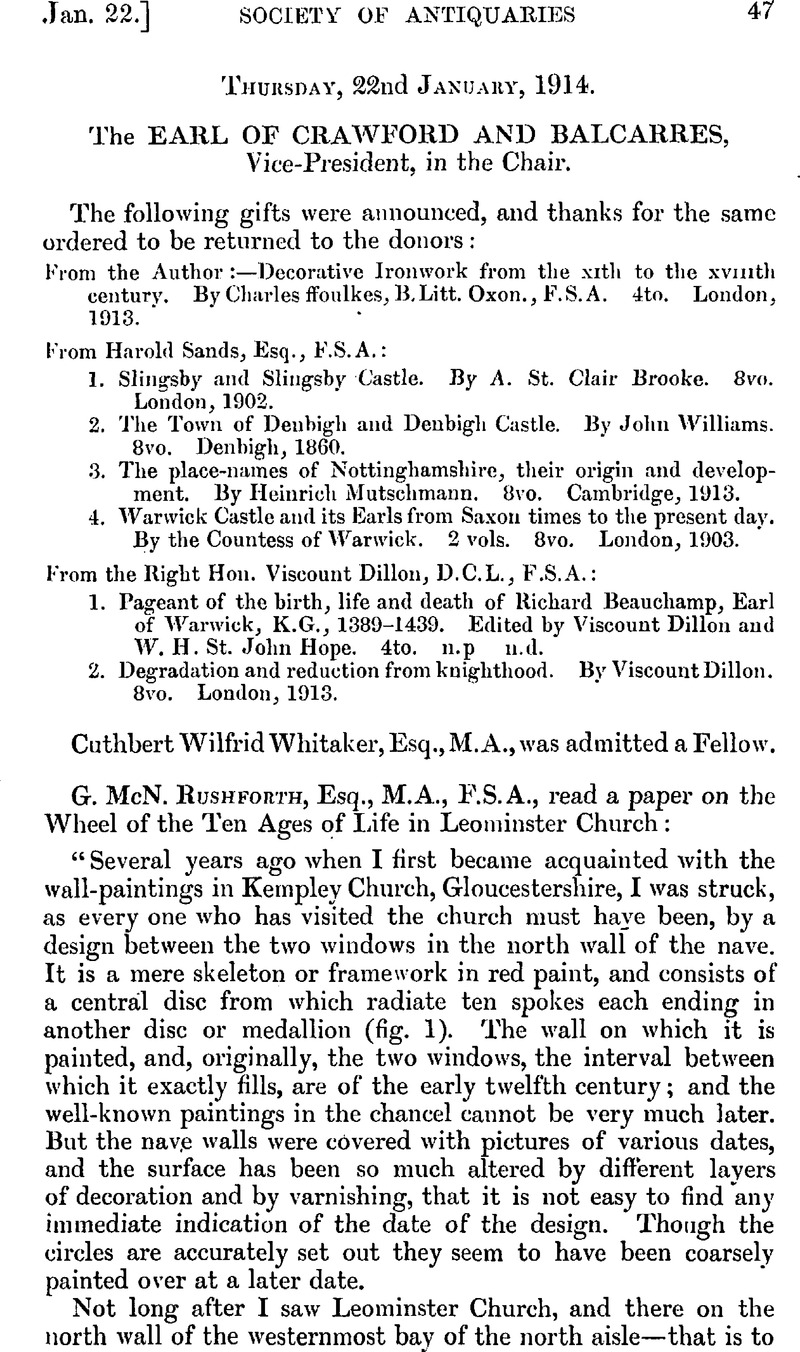No CrossRef data available.
Article contents
Thursday, 22nd January, 1914
Published online by Cambridge University Press: 10 May 2010
Abstract

- Type
- Proceedings
- Information
- Copyright
- Copyright © The Society of Antiquaries of London 1914
References
page 48 note 1 Gent. Mag., xxxix (1853), 494Google Scholar.
page 48 note 2 The illumination has been reproduced in another article on the same subject by Mr. John Winter Jones in Archaeologia, xxxv (1853), p. 167, pi. v, and in Sir G. Warner's Reproductions, iii, pi. xxiv. The latter also describes it in his Illuminated MSS. in the British Museum.
page 49 note 1 British Museum, Royal MS. 2 Bvii. In Sir G. Warner's edition (London, 1912), pi. 140 and p. 25.
page 50 note 1 Archaeologia, xxxv, 174.
page 51 note 1 G. F. Townsend, The Town and Borough of Leominster (Leominster, 1862), p. 229 note.
page 51 note 2 Diary of the Marches of the Royal Army (Camden Society, 1859), p. 267Google Scholar.
page 55 note 1 Hieroglyphica (Basel, 1567), p. 348Google ScholarPubMed.
page 55 note 2 Archaeological Journal, xliii (1880)Google Scholar; 154, pi. vii, 375.
page 55 note 3 Ibid., p. 375.
page 56 note 1 F. X. Kraus, Geschichte der christlichen Kunst, ii, 414 sqq.
page 56 note 2 Didrou (Stokes), Christian Iconography, ii, 381. The words put into the mouth of the man in the last but one of the seven ages—‘ O Time, how thou hast deceived me!’ recall vita me decepit of the Arundel and Leominster wheels, but this may be only a coincidence.
page 56 note 3 Michel, Histoire de Tart, vol. i, part ii, p. 785, fig. 419.
page 56 note 4 Didron, Annales archéologiques, i, 217 ; Christian. Iconography (Stokes), i, 486.
page 56 note 5 De Farcy, La Broderie, pi. 48, 1, and p. 110.
page 57 note 1 Willis, R., Facsimile of the Sketch-Book of Wilars de Honecort (London, 859), pi. xliGoogle Scholar.
page 57 note 2 Engelhardt, C. M., Herrad von Landsperg (Stuttgart, 1818)Google Scholar.
page 57 note 3 Dictiomuiire raisonné de l'architecture française (Paris, 1866), viii, 38Google Scholar.
page 58 note 1 iv (1859), 113.
page 58 note 2 Abhandlmiyen dark. Akademie der Wiessenschaften su Berlin, 1892.
page 58 note 3 Bergk, Poetue Lyrici Grueci (4th ed.), ii, 51.
page 58 note 4 xxiv, 320.
page 59 note 1 Die Lebensalter, p. 33.
page 59 note 2 The passages come from the Fourth Book (πɛρ ⋯ χρ ⋯νων διαιρ ⋯σɛως) of the Tetrabiblos, for which, until the appearance of a new edition in Teuhner's Bibliotheca, reference must still be made to that printed at Basel in 1553 with the Latin version of Melanchthon (pp. 241–5).
page 59 note 3 Glücksrad und Lebensrad, p. 21.
page 60 note 1 G. Heider, Das Glücksrad, p. 114.
page 61 note 1 The late Mr. Romilly Allen unfortunately called this the figure-of-eight knot, which is different and made with a single cord.
page 63 note 1 P. M. C. Kermode, Manx Crosses, no. 51, detail on p. 34, fig. 22 (9).
page 63 note 2 Reliquary and Illustrated Archaeologist, viii (1902), 247.
page 65 note 1 A reminiscence of this style can perhaps be detected in the Psalter of Ricemarch, an Irish illuminated manuscript of the late eleventh century. See especially Bruun, Art of the Illuminated MSS. of the Middle Ages, pi. x, p. 82.
page 65 note 2 Schetelig, Kunst-Kultur, 1910, 38 ; Proceedings, xxiii, 400.
page 67 note 1 Trans. Bristol and Glouc. Arch. Soc, xiii, 122, pi. vi.
page 67 note 2 Cf. design on tortoise-brooch, 8th century: Moutelius, Öfversigt öfver den nordiska Forntidens perioder 30, fig. 39.
page 67 note 3 Outline drawing of panel in R. Allen's Early Christian Symbolism, 201.
page 68 note 1 Both figured in P. G. Thorsen's De Danske Runemindesmœrker, nos. 29, 48, 22; see also L. F. A. Wimmer, De Danske Runemindesmœrker, vol. i, pt. 2, pp. 126, 139; and vol. ii, p. 171. The Swedish stone is vol. iii, p. 132.
page 68 note 2 Oscari Montelio, 401.
page 70 note 1 Wilts. Arch. Mag., xxvii, 04.
page 70 note 2 Poole, Old Crosses of Somerset, 157.
page 71 note 1 Fraucis Bond, Fonts and Font-covers, 103.
page 71 note 2 Trans. Bristol and Glouc. Arch. Sou., xiii, 118 ; Builder, 18883 pp. 196 (plate), 218, 234, 253.
page 72 note 1 See Hill, G. F., Medallic Portraits of Christ, in the Reliquary and Illustrated Archaeologist, 1904, pp. 173–93Google Scholar.




